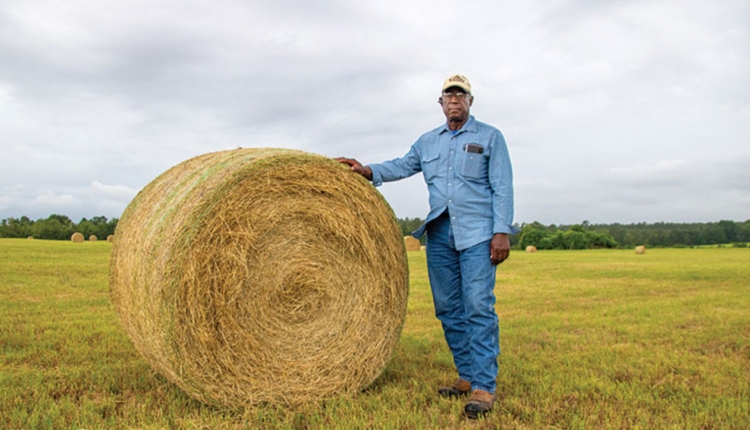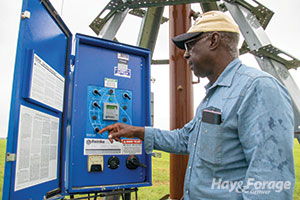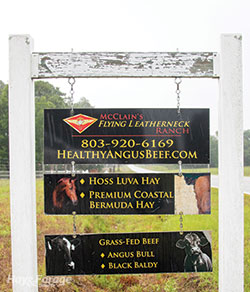Making hay was a part of his flight plan |
| By Amber Friedrichsen, Associate Editor |
|
|
|
The author served as the 2021 and 2022 Hay and Forage Grower summer editorial intern, and is now associate editor. She graduated from Iowa State University where she is majoring in agricultural communications and agronomy.  The skills Jim McClain gained in the Marine Corps have proved useful in building a successful hay business. As the son of two sharecroppers, Jim McClain grew up picking cotton and cutting tobacco in the sticky heat of South Carolina. Fields were cultivated by mules pulling plows, and crops were planted and harvested by hand. The long days of tedious work molded him into a disciplined young man, but he still yearned for adventure. McClain was fascinated with flying, and he fixated on anything with wings, from airplanes to birds to June bugs. In fact, he used to capture these iridescent insects and tie strings around their legs like makeshift kites so he could analyze their aviation. With flying and farming defining his formative years, McClain had two distinct goals for his future: To learn how to fly and to be a cowboy. The former was accomplished when he became a pilot in the Marine Corps after graduating from college. McClain and his fellow pilots were nicknamed flying leathernecks because of stiff leather collars on the original uniforms Marines wore to protect them from cutlass slashes by the enemy. After serving in two wars, making countless flights across the country and overseas, and eventually settling down in California to raise a family, McClain retired from the military in the early 1990s. But he wasn’t finished pursuing his dreams. In 1993, McClain uprooted his life in California and moved back to his home state when his wife, Linda, a real estate appraiser, found a farm outside of Orangeburg, S.C., that was up for foreclosure. Even though the house was falling apart at its hinges and the rest of the land was shrouded with shrubs and trees, she was eager to close the deal on her husband’s behalf. Becoming a cowboy — or haymaker — was finally in his reach. While Linda repaired the house, McClain cleared the land, installed fences, built a barn, and constructed a shed. The U.S. military veteran turned the place into a fully functioning farmstead and named it The Flying Leatherneck Ranch to signify the promises he made to himself when he was just a kid. Self-taught student During McClain’s renovations, he established 600 acres of Coastal bermudagrass across multiple fields; however, he didn’t have any experience growing forage. He devoted countless hours to studying different production practices and was determined to implement some of the strategies he observed when he lived in the West. By applying the problem-solving skills he strengthened in the service, McClain essentially taught himself how to make hay. “I come from a world of technology, so I made comparisons as best as I could,” he said. “I spent a great amount of time in Arizona and California, and even though they grow a different kind of hay there, the equipment is the same.” McClain was also intrigued by agriculture in other countries, so he invested in many of the haymaking machines he saw in Germany when he traveled there as a Marine. With a mower, a tedder, a rake, a small square baler, a round baler, and two stack wagons, McClain was prepared to tackle production. There were many avid equestrians in his area of the Palmetto State, creating a constant demand for premium hay with high crude protein and fiber digestibility. McClain started selling hay to a stable owner, and word of his new business quickly spread. He now produces over 45,000 small square bales and 3,500 round bales every year, and his clients recognize the consistent quality of his product that results from his meticulous attention to haymaking details. “My customers love their horses, and I love them for loving their horses,” McClain laughed. “They want the best hay they can afford in terms of nutrition, and my hay meets their standards.” An unusual approach Coastal bermudagrass is ideal for horse hay because of its fine stems and palatability. The perennial warm-season species tends to break out of dormancy in late February to early March, and first cutting occurs in mid-May once plants are 18 to 24 inches tall. McClain can get two to three cuttings from fields without irrigation each season, whereas his irrigated fields are harvested four to five times, or every 28 to 30 days. Many producers irrigate hay in the West, but it is not a common tactic in the Southeast. Nonetheless, McClain has center pivot irrigators in two of his largest fields that account for nearly one-third of his total acreage. Instead of relying on irregular rainfall, ground water is pumped to the pivots at the push of a button. To maximize cost-efficiency, McClain programs the systems to run between 10 p.m. and 10 a.m. when electricity rates are lowest.  Two of Jim McClain’s largest hayfields are pivot irrigated, which is unusual in his area but helps ensure he will have a ready supply of hay for his customers. With the help of two part-time employees, McClain cuts hay with a John Deere 956 MOCO that has an impeller conditioner, which is crucial to facilitate dry down in the humid climate. The impellers remove the waxy surface of bermudagrass stems to promote faster dry down times. Hay is then tedded to accelerate drying even further, and later raked into windrows with a Claas 680 carousel rake after three or four days. To make small square bales, McClain has a Massey Ferguson 1840 in-line baler and a New Holland 575 baler. These machines have sensors that signal the application of propionic acid if forage is more than 16% moisture. Bales are then loaded onto a self-propelled New Holland bale wagon, which is McClain’s favorite piece of equipment. It only takes about 10 minutes to pack 163 small square bales on the platform and haul them to the barn. The unloading process is hands-free. “The stack wagon is my pride and joy. I’m the only one who operates it,” McClain beamed. “Small square bales are so labor intensive. I couldn’t do business if I didn’t have it.” McClain uses a John Deere 459 baler and a New Holland 7060 baler for round bales. He has another bale wagon designed to carry 14 round bales at a time, and these bales are stacked four-high in the same barn. One of his horse customers buys nearly 1,000 round bales a year. Horse-approved hay  McClain sends hay samples to a lab in New York that specializes in forage analysis for equine diets and receives results within a week. He then shares this information with his customers to justify an asking price, but with recent inflation, he is not willing to negotiate. McClain applies a nitrogen-sulfur liquid fertilizer to his fields after each cutting, but the product he uses was double the cost in 2022 compared to years prior. Diesel fuel has also been extremely expensive, so he has bumped up his hay prices and started charging buyers a delivery fee. “I’m very candid with my customers. I tell them what I am dealing with and explain why I cannot sell my hay for what I did last year,” McClain asserted. “I can’t absorb these costs. They have to be shared.” Because of the caliber of his product and his transparency, business has remained steady. Many buyers contract bales in advance, but McClain doesn’t collect payment until they receive their order. He is confident he can supply the quantity and quality of hay to meet their needs, which speaks to his diligent approach. In addition to hay, McClain also has a herd of 150 Black Angus cow-calf pairs. He allocates about 150 acres of bermudagrass pasture for grazing, which is divided into 18 paddocks. Pearl millet is also seeded for summer grazing, and each paddock is complete with a water tank and ample shade. McClain sells grass-fed beef direct-to-consumer with intentions of educating others about where their food comes from and how his animals were raised. A word of advice Even though he doesn’t wear a wide-brimmed hat or throw a lasso, McClain considers himself the cowboy he always aspired to be. When he isn’t tedding, raking, or baling hay, he can most likely be found in the stack wagon, moving cattle, or making deliveries. He doesn’t take any of these tasks for granted because each of them is a chance to live out his childhood dreams. With that said, McClain still flies whenever he can. He owns an airplane and takes it on joyrides several times a week. Although he spends most of his time in the air alone, his grandchildren occasionally come to visit and accompany him in the cockpit. McClain takes advantage of these moments to teach them about the aircraft and make them his mini co-pilots. He hopes he can instill the desire to farm and fly in his grandchildren, but more importantly, he hopes his story encourages them — and the rest of the next generation— to follow their own trajectory. “I want people to know that where they come from in life has little bearing on their final destination,” McClain said. “Anyone can make a future for themselves with a lot of hard work and dedication to the final goal.” Note: This item received" Story of the Year" from the Agricultural Communicators Network in 2023. This article appeared in the February 2023 issue of Hay & Forage Grower on pages 22-24. Not a subscriber? Click to get the print magazine. |
